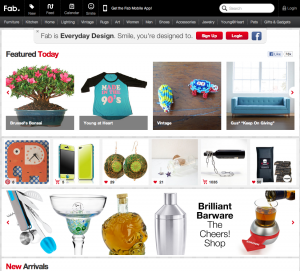You know how the saying goes: you always want what you don’t have.
That seems to be proving itself over and over in retail these days, with major retailers like Best Buy and Wal-Mart desperate to gain market share online and online retailers like Bonobos and Warby Parker eager to have ground presence. The next in this online to brick and mortar trend is Fab.com, one of 2012’s best recognized online startups. 
According to an article in WIRED, a Fab store is a question of when, not if. The company’s CEO, Jason Goldberg, said that should be sometime in the next year. He told Wired that through Fab retail locations, he wants to “reinvent the entire retail experience, not just put some Fab products on a shelf.” And he doesn’t mean pop-up stores – he imagines a Fab flagship store likely in New York City, where the company is based. He did not disclose details to Wired, but he used art – which makes up 12 percent of Fab’s sales – as an example. Since people are often intimidated to buy art from a gallery, said Goldberg, Fab wants to offer an “easier and less-scary way” to pick out a painting to hang on the wall or a sculpture to perch in an entryway. He didn’t talk about more than art, but the notion is intriguing for sure.
While Fab started as a flash sale site similar to others of that model like Gilt Groupe, it has expanded into a full-blown online retailer with a massive stock of quirky goods from vintage home furniture to art to handmade clothing and more.
According the Wired article, Fab grew from 1.5 million members in December 2011 to 10 million in December 2012; inventory expanded from 2,000 products to 15,000; and sales topped $1 million per day on several occasions.
“We found that people weren’t coming to Fab with the perception of getting a deal, so we saw an opportunity to build a long-term brand,” said Goldberg. To him, this meant that building a full-fledged digital storefront, with a mix of limited-quantity goods and products that are consistently available, was a must (and certainly an impetus for him wanting to expand to physical retail locations).
In July 2012, Fab raised $105 million to lease a warehouse, build its own supply chain, and purchase inventory. “If someone orders something that’s in our warehouse, which is 75 percent of what we sell, it starts shipping in two hours,” Goldberg said.




Recent Comments